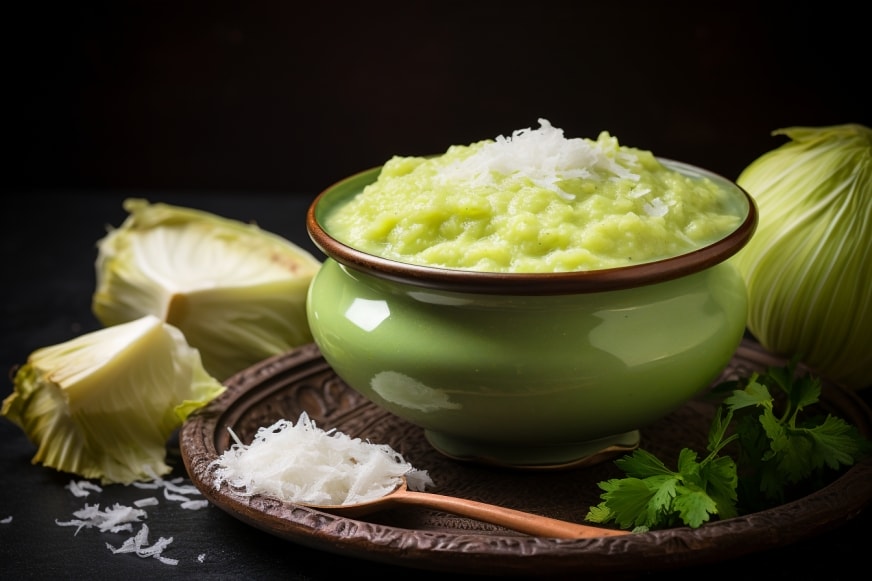Table of Contents
ToggleCuban Coconut Cabbage: Coconut Milk and Cabbage Puree for Your Little One’s Culinary Adventure
Step into a world where the golden sun kisses your skin, where the rhythm of the ocean’s waves becomes the backdrop to your every step, and where the vibrant tapestry of Caribbean culture envelopes you in its warm embrace. The Caribbean – a land of captivating landscapes, rich traditions, and, of course, its irresistible cuisine. And what better way to introduce your little one to this world of flavors than through a delightful culinary concoction, lovingly crafted from the heart of the Caribbean – introducing the Cuban Coconut Cabbage: Coconut Milk and Cabbage Puree.
Imagine standing on a sandy shore, the soft breeze carrying with it whispers of tantalizing aromas that weave tales of distant lands. The scent of coconuts fills the air, as their creamy essence infuses everything from savory stews to decadent desserts. The coconut, a treasure trove of nourishment and flavor, has long been cherished in Caribbean households, passed down through generations as a culinary legacy.
Coconuts aren’t just ingredients; they’re a cultural cornerstone, an integral part of celebrations and gatherings that bring communities together. From breaking open a freshly fallen coconut at festive occasions to savoring the richness of coconut milk in everyday dishes, the coconut’s presence is undeniable. It’s a taste of tradition, a sip of history, and an immersion in the spirit of the islands.
But what about cabbage? A humble cruciferous vegetable, often overlooked, but in the Caribbean, it finds its place as a culinary chameleon. It seamlessly melds with the tropical essence of coconut, adding its own layers of texture and flavor to the mix. From the comforting embrace of hearty stews to the zesty crunch in vibrant salads, cabbage dances across plates, offering a symphony of tastes with every bite.
As a parent with roots in the Caribbean, this culinary fusion holds a special place in my heart. The Cuban Coconut Cabbage puree isn’t just about introducing new flavors to your baby; it’s about fostering a connection to a culture, a heritage, and a way of life. It’s about weaving stories and memories with each spoonful, inviting your little one to embark on a journey of discovery.
So, as you embark on this culinary adventure, let the Cuban Coconut Cabbage puree be a bridge between generations – a conduit that channels the essence of the Caribbean into your baby’s world. With every taste, you’re not just offering nourishment; you’re crafting a connection that spans time and place, creating a tapestry of flavors that’s uniquely yours.
Join me as we journey deeper into the heart of this enchanting puree, uncovering the rich history, exploring the nutritional treasures it holds, and embracing the joy of watching your little one’s taste buds awaken to a world of Caribbean delights.

Unveiling a Fascinating Background
The heart of Caribbean cuisine beats to the rhythm of its people’s history, echoing tales of colonization, trade winds, and the fusion of cultures. At the heart of this culinary journey lies the coconut – a true embodiment of the Caribbean spirit. From the sun-kissed shores to the lush interior, coconuts have been an essential part of everyday life for generations.
The coconut’s journey in the Caribbean dates back centuries, intertwining with the region’s history in profound ways. The first coconut palms found their way to these shores through the ancient maritime trade routes, carried by winds and currents that linked far-flung lands. As these palms took root, they not only provided a valuable source of sustenance but also became symbols of resilience, thriving against the backdrop of the tropical landscape.
But the coconut wasn’t merely sustenance; it was an integral part of rituals and celebrations. Imagine the communal gatherings under swaying palm fronds, where coconuts were cracked open in celebratory fashion. The sweet water within, known as agua de pipa, offered a refreshing and hydrating elixir, especially cherished in the Caribbean’s warm embrace. The meat, whether enjoyed fresh or grated, lent a luxurious creaminess to dishes, infusing them with a taste that was uniquely Caribbean.
As time went on, coconuts became woven into the fabric of Caribbean culture. They found their way into every aspect of life – from cuisine to crafts, from medicine to rituals. In Caribbean kitchens, coconut milk transformed dishes into velvety indulgences, while coconut oil brought depth and flavor to culinary creations. Even the shells and fibers found new purpose as vessels for art and craft, a testament to the resourcefulness that defined island life.
Enter the cabbage – an unexpected companion in this culinary narrative. While coconuts held the spotlight, cabbage made its quiet presence felt, adapting and flourishing in the Caribbean’s fertile soil. In Caribbean households, cabbage was revered for its versatility, effortlessly adapting to both traditional and contemporary dishes. It played a role in iconic stews like ropa vieja and found its way into crunchy slaws that balanced the richness of coconut-infused feasts.
The marriage of coconut and cabbage was more than a culinary choice; it was a harmonious blend of textures, flavors, and histories. This combination showcases the Caribbean’s ability to seamlessly integrate diverse elements, creating a sumptuous tapestry that pays homage to its past while embracing the present.
So, as we delve deeper into the Cuban Coconut Cabbage puree, remember that every spoonful is a taste of history. It’s a glimpse into the resilience of a region that has weathered storms, celebrated triumphs, and woven its essence into each coconut kernel and cabbage leaf. Join me as we honor the past and savor the flavors that continue to unite generations, painting a vibrant portrait of Caribbean cuisine.

Unveiling a Fascinating Background
Let us take a leisurely stroll down the sun-kissed paths of Caribbean history, where the whispers of trade winds and the melodies of tropical waves create an eternal symphony. Amidst this picturesque backdrop, the essence of Caribbean cuisine comes alive – a melody of flavors that reverberate with stories of colonization, cultural exchange, and the unyielding spirit of its people. And at the heart of this culinary saga stands the humble yet majestic coconut.
The Caribbean’s love affair with coconuts is an affair as old as time itself. Picture this: ancient mariners navigating the azure waters of the Caribbean Sea, trading winds that carried not only their ships but also the promise of a new world. These voyagers brought with them coconuts – the seeds of a tropical wonder that would forever entwine with the fabric of Caribbean life.
As these palms took root on the sandy shores, they stood as sentinels of resilience against the elements. Coconuts soon became more than a source of sustenance; they were a symbol of abundance and adaptation. The versatile coconut palm provided food, shelter, and materials for tools and crafts. Its fronds swayed in the breeze like dancers celebrating life, while its fruits held secrets within their rugged shells.
But coconuts weren’t just functional – they were integral to the region’s culture and traditions. Imagine the joyous moments of coconut cracking during celebrations, where the sweet water – agua de pipa – flowed freely, quenching the thirst of revelers and forging connections. The richness of coconut milk transformed dishes into luxuriously creamy delights, and the oil added depth to flavors, infusing dishes with a distinct Caribbean character.
Yet, the story of coconuts is only part of the narrative. Enter the unassuming cabbage, a lesser-known protagonist in the Caribbean culinary tale. Against the backdrop of coconut palms, cabbage thrived, embracing the tropical climate and finding its place among the region’s bounty. This cruciferous gem lent its versatile presence to a myriad of dishes, both traditional and contemporary.
In Caribbean households, cabbage was cherished for its adaptability. From the comforting heartiness of traditional stews to the crisp vibrancy of slaws, cabbage seamlessly integrated into the culinary mosaic. Its arrival on the Caribbean table added layers of texture and crunch, balancing the richness of coconut-infused feasts and offering a delightful counterpoint.
And thus, the convergence of coconut and cabbage is not just a culinary marriage but a harmonious blend of two worlds. It’s a testament to the Caribbean’s innate ability to create unity from diversity, fusing elements from near and far to craft culinary symphonies that tantalize the senses.
So, as we embark on our journey through the Cuban Coconut Cabbage puree, let’s remember that each spoonful carries with it the echoes of history. It encapsulates the spirit of a region that has woven its cultural identity into every coconut grove and cabbage patch, celebrating the flavors of the past while embracing the promises of the future. Join me as we delve into this culinary canvas, savoring the intricate brushstrokes that have painted the vibrant masterpiece of Caribbean cuisine.
Special Baby Preparation Tips
Preparing a culinary masterpiece for your little one isn’t just a task – it’s an art that demands attention to detail, love, and an understanding of your baby’s unique needs. As we embark on the journey of crafting the perfect Cuban Coconut Cabbage puree, let’s dive into a treasure trove of special tips that ensure a delightful and nourishing experience for your precious bundle of joy.
Selecting the Freshest Ingredients
Embark on your culinary adventure armed with the freshest bounty. When it comes to cabbage, choose heads that are firm, with vibrant, crisp leaves. Opt for organic or pesticide-free produce whenever possible, minimizing your baby’s exposure to unnecessary chemicals. For coconuts, if using fresh ones, seek out ones that feel heavy for their size – a sign of ample coconut water within.
Handling and Washing Cabbage
Before diving into preparation, it’s crucial to ensure that your ingredients are clean and safe for your baby. Carefully remove the outer leaves of the cabbage and give it a thorough rinse under cold water. Consider using a vegetable brush to gently clean the crevices where dirt might be hiding. Proper washing reduces the risk of any contaminants making their way into your puree.
Choosing the Right Coconut Milk
Coconut milk is the soul of our puree, and choosing the right kind can make a world of difference. If opting for canned coconut milk, go for the unsweetened variety without any additives. However, if you’re ready to take on an extra step, using fresh coconut milk can elevate the flavor profile. To make your own, blend grated coconut with warm water and strain the mixture to extract the creamy liquid – a labor of love that promises a reward of authenticity.
Retaining Maximum Nutrient Value
Cooking methods can impact the nutrient content of your puree. While sautéing is our chosen path for the Cuban Coconut Cabbage puree, consider alternative methods like steaming or baking. These gentler methods help retain more of the vitamins and minerals present in both cabbage and coconut milk. The goal is to serve up a wholesome meal that’s not only delicious but also packed with nutritional goodness.
Seasoning with Care
As we infuse our puree with the warmth of ground cumin, remember that babies have sensitive taste buds. Start with a gentle touch of seasoning and gradually increase it based on your baby’s reactions. Avoid adding salt, as babies’ kidneys are still developing, and their sodium needs are minimal. Focus on letting the natural flavors of cabbage and coconut shine while introducing them to the subtle allure of spices.
Armed with these special preparation tips, you’re ready to embark on your culinary journey with confidence. Remember, crafting a baby’s meal isn’t just about nourishing their body; it’s about nurturing their taste preferences and building a foundation for a lifetime of healthy eating. So, let’s roll up our sleeves, gather our ingredients, and let the culinary symphony of the Cuban Coconut Cabbage puree begin!

Important Key Takeaways
| Key Nutrients | Role in Baby’s Development |
|---|---|
| Vitamins and Minerals in Cabbage | Cabbage is a treasure trove of vitamins, including vitamin K for strong bones, vitamin C for immune support, and folate for cell growth. These nutrients lay a strong foundation for your baby’s growth and overall health. |
| Medium-Chain Triglycerides (MCTs) in Coconut Milk | Coconut milk’s MCTs are easily digestible and quickly converted to energy. They provide essential fatty acids that support your baby’s brain development, cognitive function, and immune system, making it a nutritional powerhouse. |
| Dietary Fiber | Both cabbage and coconut milk contribute to the fiber content of the puree. Fiber aids in digestion, promotes a healthy gut, and supports regular bowel movements, ensuring your baby’s tummy is happy and comfortable. |
The Cuban Coconut Cabbage puree isn’t just a delicious culinary creation; it’s a nutritional powerhouse that lays the groundwork for your baby’s development. By understanding the key takeaways, you’re equipped with the knowledge to make informed choices that nurture your baby’s growth and well-being.
As you serve up spoonfuls of this delightful puree, know that you’re not only introducing your baby to new flavors but also providing them with a symphony of nutrients that support their journey toward a bright and healthy future.

Benefits for Baby
Embarking on the journey of introducing your baby to solid foods is a milestone that opens up a world of flavors and possibilities. The Cuban Coconut Cabbage puree isn’t just a culinary delight; it’s a gateway to a myriad of benefits that nurture your baby’s growth, development, and culinary curiosity.
Cultivating Adventurous Taste Buds
Early exposure to a diverse range of flavors lays the foundation for adventurous eating habits in the future. By introducing your baby to the vibrant fusion of coconut and cabbage, you’re expanding their palate and encouraging them to embrace new tastes with enthusiasm. This openness to flavors sets the stage for a lifetime of enjoying a wide variety of foods, fostering a love for healthy eating.
Exploring Textures and Developing Skills
The Cuban Coconut Cabbage puree offers a delightful dance of textures – the creaminess of coconut milk and the slight crunch of sautéed cabbage. As your baby experiences these contrasting textures, they’re not only delighting their senses but also developing crucial oral motor skills. The act of tasting and manipulating different textures helps strengthen their jaw muscles and improves coordination, setting the stage for successful self-feeding down the road.
Supporting Digestion and Gut Health
The combination of cabbage’s dietary fiber and the medium-chain triglycerides (MCTs) in coconut milk forms a powerful duo for your baby’s digestive health. Fiber aids in digestion and promotes regular bowel movements, while MCTs contribute to a balanced gut microbiome. A happy tummy means a happy baby, and the Cuban Coconut Cabbage puree offers just that – a blend that nurtures from the inside out.
Aiding Brain Development and Immunity
Coconut milk’s MCTs aren’t just beneficial for digestion; they also play a pivotal role in supporting your baby’s brain development. These healthy fats are a source of energy for growing brains and contribute to cognitive function. Additionally, the immune-boosting properties of coconut milk provide an added layer of protection, helping your baby’s body ward off common illnesses as they explore the world around them.
Nourishing Energy for Growth
Babies are bundles of boundless energy, and the Cuban Coconut Cabbage puree offers a source of nourishing energy that fuels their growth and exploration. The combination of healthy fats, vitamins, and minerals provides a balanced nutritional profile that supports your baby’s overall well-being, ensuring they have the energy they need to thrive.
As you embark on this culinary journey with your baby, remember that the benefits of the Cuban Coconut Cabbage puree extend far beyond the plate. Each spoonful nourishes not only their body but also their senses, their development, and their lifelong relationship with food. So, savor these moments of discovery and delight, knowing that you’re nurturing a foundation of health and happiness for your little one.
Prepare to embark on a culinary adventure that fuses the essence of the Caribbean with the goodness of nourishing ingredients. The Cuban Coconut Cabbage puree isn’t just a dish – it’s a symphony of flavors that will delight your baby’s taste buds and nourish their growing body.
Ingredients:
- 1/2 cup shredded cabbage (green or Napa)
- 1/4 cup coconut milk (unsweetened)
- 1 teaspoon olive oil
- 1/4 teaspoon ground cumin
- A pinch of salt (optional)
Steps:
- Start by gently sautéing the shredded cabbage in a teaspoon of olive oil. The cabbage should begin to soften and release its natural sweetness.
- As the cabbage takes on a slight translucence, it’s time to introduce the star of our show – coconut milk. Pour in 1/4 cup of unsweetened coconut milk and give the mixture a gentle stir. The aroma of coconut will meld with the earthy notes of cabbage, creating a symphony of scents that’s a testament to the Caribbean’s culinary magic.
- To elevate the authenticity of our puree, add a quarter teaspoon of ground cumin. This spice not only adds a subtle warmth but also transports you to the heart of Cuban cuisine. Let the cumin infuse the puree with its aromatic embrace, ensuring that each spoonful is a journey in itself.
- Now, cover the pan and let the ingredients simmer on medium-low heat for about 8-10 minutes. This gentle simmer allows the flavors to meld while preserving the nutritional goodness of the ingredients.
- Once the cabbage reaches a tender texture and the coconut milk has woven its magic, it’s time to blend. Transfer the mixture to a blender or food processor and blend until you achieve a velvety smooth consistency. The puree’s creamy texture is a testament to the harmony between cabbage’s crunch and coconut’s silkiness.
- If desired, add a pinch of salt to taste. Remember that baby’s sodium needs are minimal, so exercise moderation if you choose to include salt.
- With a final swirl of the spoon, your Cuban Coconut Cabbage puree is ready to grace your baby’s palate. Serve it with love, savoring each spoonful as you witness your little one’s delight in this culinary masterpiece.
The Cuban Coconut Cabbage puree isn’t just a dish; it’s a journey that connects your baby to the rich tapestry of Caribbean culture. As you create this culinary masterpiece, take a moment to appreciate the flavors that span generations, weaving a story of tradition, nourishment, and love.
Want to take your knowledge to the next level? Check out these must-read articles:
- Reggae Rice Pudding: Caribbean Rice Pudding with Cinnamon
- Island Banana Biscuits: Vegan Banana and Oat Biscuits for Toddlers
Organize your baby’s wardrobe with our baby clothes closet organizer products! Our organizers are designed specifically for baby clothes. Get your baby’s clothes neat and tidy with our selection of organizers – shop now!
- The Organic Baby Food Debate: What Actually Matters - July 2, 2025
- The Science of Baby Hunger Cues: Reading Your Child’s Signals - April 28, 2025
- Bottle Acceptance Strategies for Breastfed Babies - April 27, 2025



